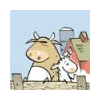My Pet World: New book helps owners pick the best food for their dogs
Pet food is a religion to an increasing number of pet owners. These pet "parents" have strong and often uncompromising opinions about how to feed their best friends.
"The loyalty might be to a brand, but more often, it's to a specific food type, like raw, or all organic or moist food only," says nutritionist Linda Case, author of "Dog Food Logic: Making Smart Decisions for Your Dog in an Age of Too Many Choices" (Dogwise Publishing, Wenatchee, WA, 2014; $19.95).
Are these unwavering feelings misguided?
"Emotions have a lot to do with how we make decisions and how we remember things," says Case. "That passion informs decision making. Sometimes we're right and sometimes we're wrong."
If you know where to look, and seek unbiased sources through websites, blogs and online discussion groups, it is possible to find factual information about pet food. However, Case notes that people tend to search for others who already agree with their pre-conceived notions.
"A very big part of the book is teaching people critical learning skills," says Case. "One goal is to teach pet owners how to become citizen scientists. The truth is, so much of what's out there (online) should be considered with a very skeptical eye; the information highway is cluttered with a great deal of misinformation."
Case adds that picking food is incredibly important to many pet owners for various reasons. For starters, you have total control over what your pet is eating. What you can't control is nearly anything else.
"As human beings, we want that control," says Case says. "Also, many pet owners believe that pet food is the most significant factor contributing to a dog's longevity."
Is that belief based on fact?
"Certainly, pet food can matter, but how much will it alter the destiny of your animal?" Case wonders. The answer is, "it depends," and the complete answer is open to debate.
Choosing a food can be overwhelming. Some pet stores offer hundreds of options, including not only many brands, but also food for different life-stages, lifestyles, and specific breeds. Then there's the question of whether to choose moist or dry food, semi-moist or frozen?
"It's enough to make your head spin," says Case. Furthermore, you need to be able to differentiate between what's marketing and what's real. Some terms on packaging, such as "all natural," mean very little. Other key words may mean much more, such as those describing diets appropriate for a dog's life-stage. Puppy diets, for instance, are appropriate for the typically higher energy needs and somewhat higher protein needs of pups.
"If the puppy is a large or giant breed puppy (such as a Great Dane or Irish Wolfhound), there's evidence that they do best with a lean diet and moderately reduced calcium levels," says Case. "The purpose is to moderate the growth rate, in part, for skeletal health, preventing hip dysplasia or shoulder and knee problems which (can be caused by)a very rapid growth rate early in life. For all puppies, a puppy food is a good idea."
Some of the widespread fixation on pet food -- sometimes trending toward alternative approaches -- can be traced to a loss of consumer trust following the massive 2007 pet food recall. Many pets died and thousands were sickened after eating various brands of pet food imported from China that were tainted with melamine and Cyanuric acid. More recently, there have been concerns about chicken jerky treats made in China.
In her book, Case, notes that since 2007 pet food recalls have risen. In 2011, 26 pet food companies recalled 131 products, and in 2012, 24 companies recalled 67 products. If control is important to consumers of pet food, they lose control when products are recalled.
There was an uptick in sales of so-called raw diets following the 2007 recall. These diets contain raw meat, low amount of grains, and are fed frozen and thawed or dehydrated and rehydrated with water. They're available commercially or can be prepared at home.
However, while it seems there's more consumer control and safety with raw choices, that's not really true. There have been recalls of raw diets, too. And several studies point to salmonella concerns, particularly for people preparing the diets.
Case adds that the belief that raw diets best suit dogs' needs because they replicate wolf diets may not be true. Wolves and dogs have different nutritional needs as a result of being separated by thousands of years of evolutionary history.
"The fact is, there are many right ways to feed our pets," says Case. "Just like we can live well and get completely nutritious diets in Japan, (we can) also live well with balanced diets in Italy, though the two diets are very different. What's most important is that we do our homework, become well-informed and learn to see through the marketing hype."
========
Steve Dale welcomes questions/comments from readers. Although he can't answer all of them individually, he'll answer those of general interest in his column Send e-mail to PETWORLD(at)STEVE DALE.TV. Include your name, city and state. Steve's website is www.stevedalepetworld.com; he also hosts the nationally syndicated "Steve Dale's Pet World" and "The Pet Minute." He's also a contributing editor to USA Weekend.
(c) 2014 DISTRIBUTED BY TRIBUNE MEDIA SERVICES, INC.






